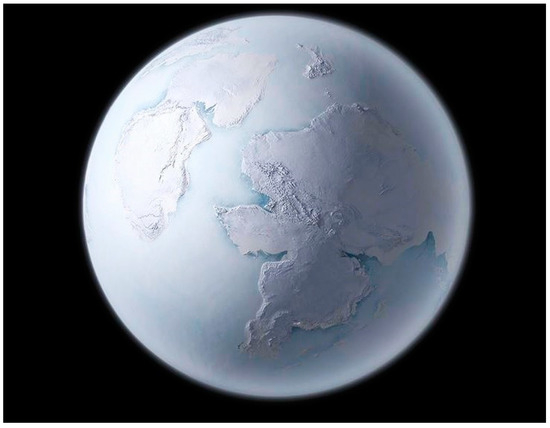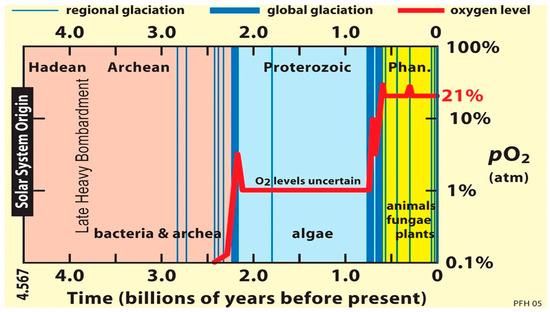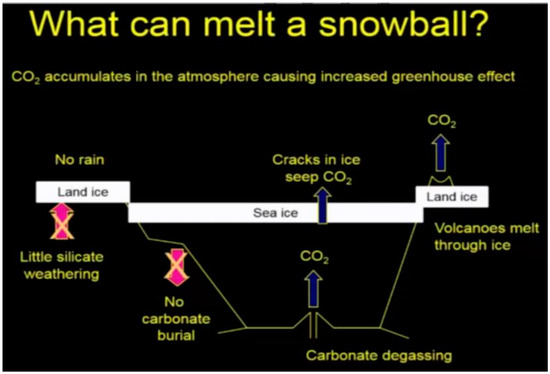Abstract
Throughout the history of Earth, significant changes in its climate and consequent alterations to its surface have been recorded. One of the most extreme forms is the complete coverage of the planet by ice, known as Snowball Earth. This theory explains numerous findings from archaeological studies conducted worldwide during the Neoproterozoic Period. However, despite increasing evidence of intense climatic fluctuations occurring during this period, the theory of complete ice coverage is not widely accepted by the scientific community. In this work, we present a critical bibliographic review of the main points of this theory, shedding light on its key aspects and unresolved debates.
Keywords:
albedo; atmosphere; biosphere; climate; climate dynamics; geosphere; global glaciation; glacier; Snowball Earth; tectonics 1. Introduction
The existence of Snowball Earth is a subject of ongoing discussion among scientists. However, their views agree that deciphering paleogeography and biology during the period of extensive glaciation is a necessary condition for understanding the interactions between life, tectonics, and climate. The Snowball Earth hypothesis proposes that during the Neoproterozoic Period, the planet was entirely covered in ice, leading to significant changes in the Earth’s climate and surface. In this critical bibliographic review, we examine the main points of contention surrounding the Snowball Earth hypothesis, addressing the following research questions: (1) what were the periods of the appearance of the phenomenon? (2) what were the causes of the creation of Snowball Earth? (3) what were the impacts of Snowball Earth on life? and (4) What was the reset mechanism that allowed the Earth to recover from periods of complete ice cover?
Through a comprehensive analysis of primary and secondary sources, including scientific articles, books, and conference proceedings, we synthesize and evaluate the existing literature to shed light on these research questions and deepen our understanding of Snowball Earth. Our review reveals that while evidence for Snowball Earth is compelling, significant uncertainties remain regarding the timing, causes, and consequences of these extreme glaciation events. Moreover, recent advances in scientific understanding of climate dynamics and feedback mechanisms have challenged traditional assumptions about the Earth’s response to extreme cold periods.
Our analysis highlights the importance of conducting continued research in this area, particularly in terms of improving our understanding of the interactions between the biosphere, atmosphere, and geosphere during periods of global glaciation. This critical review contributes to ongoing debates about the Snowball Earth hypothesis by synthesizing and evaluating the existing literature and posing key research questions for consideration in future studies.
2. The “Snowball Earth” Phenomenon
2.1. Definition
The Snowball Earth phenomenon describes a global climate characterized by extremely low temperatures and the entire surface of the planet being covered in ice, i.e., from the poles to the equator (Figure 1). In this state, the reflectivity of the Earth’s surface significantly increases, and most solar radiation is reflected back into space from the frozen surface, resulting in a high albedo effect that further amplifies the cold climate. The global average temperature during this period is estimated to be approximately −50 °C, with even lower temperatures reaching −20 °C at the equator, resembling the current temperature of Antarctica. The Snowball Earth hypothesis is rooted in compelling findings that indicate intense and successive climatic fluctuations occurred during the Neoproterozoic Era [1] These fluctuations have been inferred from various sources, including geological records, isotopic compositions, and sedimentary deposits, providing valuable insights into the climatic conditions and environmental changes that shaped our planet’s history.

Figure 1.
Artwork depicting Earth during the Cryogenian period, which was characterized by glaciations. Earth is shown during the Sturtian glaciation (approximately 750 to 700 million years ago), with the supercontinent Rodinia beginning to break apart. (MIKKEL JUUL JENSEN/SCIENCE PHOTO LIBRARY).
2.2. Periods of Occurrence of the Phenomenon
In many research locations around the world, the presence of two distinct glacial events with cap carbonates has been identified, indicating the occurrence of at least two global glaciations: one event that started at the end of the Sturtian period, i.e., approximately 660 million years ago, and one event that started during the Marinoan period, which ended around 635 million years ago [2]. However, there are indications from geochronological data related to carbon isotope findings that have led several scientists to believe that there were at least four events, with two events occurring in the earlier part of the Neoproterozoic (Sturtian), i.e., around 730–680 million years ago, and two later glacial events (Vendian) occurring between 650 and 585 million years ago [3]. Additionally, the case of the Huronian glaciations, which occurred as a result of the Great Oxygenation Event, that occurred between 2.5 and 2.1 billion years ago has been studied, although they likely did not simultaneously cover the entire surface of the planet (Figure 2) [4,5].

Figure 2.
The increase in oxygen levels in the Earth’s atmosphere over extended geological periods and its connection to occurrences of snowball events (represented by blue bars) and the emergence of new biological developments. [https://www.snowballearth.org/when.html (accessed on 24 August 2023)].
3. Evolution of the Phenomenon
3.1. Causes of Formation
One crucial factor that appears to have played a significant role in the formation of a global ice cover in the past is the diminished solar radiation that Earth received in comparison to the present day. Evolutionary models of the Sun indicate that its luminosity has undergone a substantial increase of approximately 40% since the planet’s inception, whereas during the Neoproterozoic Era, it was estimated to be around 7% less radiant than today [6]. This finding suggests that the emergence of the Snowball Earth phenomenon would have been more probable during the early stages of Earth’s existence. However, the occurrence of such an extreme event necessitates interplay between various additional factors.
Of particular significance is the vertical expansion of Earth’s overall albedo, resulting from the extensive growth of glaciers in latitudinal bands spanning from approximately 30° to 40°, which was contingent upon diverse climatic conditions (Figure 3) [7,8,9]. Nonetheless, to attain such a pervasive glaciation, there must be perturbations in the composition of the atmosphere concerning the concentration of key greenhouse gases, such as carbon dioxide (CO2), methane (CH4), and water vapor. Numerous theories have been postulated to elucidate the reduction in these gases, with the most notable theories being expounded upon in the study by [10]. These theories predominantly center around disruptions in the carbon and methane cycles induced by both endogenous and exogenous factors and find support via the examination of isotopic ratios, particularly δ13C and δ12C.

Figure 3.
Schematic representation of the impact of glaciation on the albedo of a planet. [https://psychroteuthis.wordpress.com/2009/08/04/ice-albedo-and-the-snowball-earth-theory/ (accessed on 24 July 2023)].
3.2. Consequences for Life
The survival of living organisms in the aforementioned conditions proved to be exceptionally arduous, with the productive processes being nearly eradicated. However, through the examination of contemporary micro-organisms thriving in extreme environments, where temperatures simulate those of the Snowball Earth, it can be concluded that the existence of psychrophilic prokaryotes and eukaryotes was indeed viable [11]. Furthermore, the isolation of identical organisms in diverse locations, with each organism characterized by distinct conditions, triggered genetic mutations and facilitated the emergence of novel life forms [12]. This genetic evolution was further amplified via the subsequent transition to greenhouse conditions and the subsequent convergence of these nascent species, leading to the creation of additional distinct varieties of life.
3.3. Reset Mechanism
As previously mentioned, the significant reduction in greenhouse gases in the atmosphere played a pivotal role in triggering the planet’s dramatic freeze, ultimately leading to the phenomenon known as “Snowball Earth”. Consequently, in order to initiate the process of planetary warming, there must have been a substantial augmentation in the levels of these atmospheric gases. It is worth noting that even during a “Snowball Earth” scenario, tectonic activity would not come to a halt, implying that volcanic activity and the creation of new volcanoes would persist. Consequently, the continuous outgassing of carbon-based compounds, including carbon dioxide, would continue to enrich the atmosphere, resulting in the subsequent accumulation of methane gas [10].
Simultaneously, due to the absence of water in liquid form, the planet would experience a significant reduction in rainfall and soil erosion. As a result, these gases, namely carbon dioxide and methane, would remain trapped within the atmosphere, gradually intensifying their concentration over time. This progressive buildup of greenhouse gases would, in turn, contribute to a gradual elevation in the overall temperature of the atmosphere, ultimately leading to the gradual thawing or “defrosting” of the Earth [13].
By providing a more intricate understanding of the complex interplay between atmospheric composition, tectonic activity, and climatic conditions, this process sheds light on the mechanisms that would have facilitated the transition from a completely frozen state to a more hospitable and habitable environment. Therefore, Figure 4 visualizes and encapsulates these intricate dynamics to enable better comprehension and analysis.

Figure 4.
Schematic representation of the mechanism of recovery from the Snowball Earth state [https://quizlet.com/gb/276868853/the-snowball-earth-hypothesis-flash-cards/ (accessed on 24 July 2023)].
4. Conclusions
The existence or non-existence of a ‘Snowball Earth’ is a matter of intense scientific debate and deliberation. Researchers generally agree that decoding the ancient geography and biology originating from the era of widespread glaciation is essential to comprehending the complex interplay between life, tectonics, and climate. By expanding our knowledge of this fascinating period in Earth’s history, we can delve deeper into the intricate relationships and interactions between geological processes, living organisms, and climatic dynamics. Unraveling these connections provides profound insights into the complex web of influences that shaped the coexistence and reciprocal impacts of these intertwined domains during this remarkable epoch.
Author Contributions
Conceptualization, A.S., G.G. and S.A.; investigation A.S., F.M., G.G., I.P., K.L., S.A., V.R. and C.P.; resources, A.S., F.M., G.G., I.P., K.L., S.A., V.R. and C.P.; writing—original draft preparation, A.S., F.M., G.G., I.P., K.L., S.A., V.R. and C.P.; writing—review and editing, A.S., I.P. and S.A. All authors have read and agreed to the published version of the manuscript.
Funding
This research received no external funding.
Institutional Review Board Statement
Not applicable.
Informed Consent Statement
Not applicable.
Data Availability Statement
The data that support the findings of this study are available from the corresponding author, [AS], upon request.
Conflicts of Interest
The authors declare no conflict of interest.
References
- Evans, D.A.D. Stratigraphic, geochronological, and paleomagnetic constraints upon the Neoproterozoic climatic paradox. Am. J. Sci. 2000, 300, 347–433. [Google Scholar] [CrossRef]
- Rooney, A.D.; Strauss, J.V.; Brandon, A.D.; Macdonald, F.A. A Cryogenian chronology: Two long-lasting synchronous neoprotero-zoic glaciations. Geology 2015, 43, 459–462. [Google Scholar] [CrossRef]
- Kaufman, A.J.; Knoll, A.H.; Narbonne, G.M. Isotopes, ice ages, and terminal Proterozoic earth history. Proc. Natl. Acad. Sci. USA 1997, 94, 6600–6605. [Google Scholar] [CrossRef] [PubMed]
- Eriksson, P.G.; Lenhardt, N.; Wright, D.T.; Mazumder, R.; Bumby, A.J. Late Neoarchaeane Palaeoproterozoic supracrustal basin-fills of the Kaapvaal craton: Relevance of the supercontinent cycle, the “Great Oxidation Event” and “Snowball Earth”? Mar. Pet. Geol. 2011, 28, 1385–1401. [Google Scholar] [CrossRef]
- Williams, G.E. Subglacial meltwater channels and glaciofluvial deposits in the Kimberley Basin, Western Australia: 1.8 Ga low latitude glaciation coeval with continental assembly. J. Geol. Soc. Lond. 2005, 162, 111–124. [Google Scholar] [CrossRef]
- Gough, D.O. Solar interior structure and luminosity variations. Sol. Phys. 1981, 74, 21–34. [Google Scholar] [CrossRef]
- Poulsen, C.J.; Pierrehumbert, R.T.; Jacob, R.L. Impact of ocean dynamics on the simulation of the Neoproterozoic “snowball Earth”. Geophys. Res. Lett. 2001, 28, 1575–1578. [Google Scholar] [CrossRef]
- Budyko, M.I. The effect of solar radiation variations on the climate on the Earth. Tellus 1969, 21, 611–619. [Google Scholar] [CrossRef]
- Sellers, W.D. A global climatic model based on the energy balance of the Earth-atmosphere system. J. Appl. Meteorol. 1969, 8, 392–400. [Google Scholar] [CrossRef]
- Schrag, D.P.; Berner, R.A.; Hoffman, P.F.; Halverson, G.P. On the initiation of a snowball Earth. Geochem. Geophys. 2002, 3, 3–21. [Google Scholar] [CrossRef]
- Hoffman, P.F.; Schrag, D.P. The Snowball Earth Hypothesis: Testing the limits of global change. Terra Nova 2002, 14, 129–155. [Google Scholar] [CrossRef]
- Valentine, J.W.; Moores, E.M. Plate Tectonics and the History of Life in the Oceans. Sci. Am. 1974, 230, 80–89. [Google Scholar] [CrossRef]
- Kirschvink, J.L. Late Proterozoic low-latitude global glaciation: The snowball Earth. In the Proterozoic Biosphere; Schopf, J.W., Klein, C., Eds.; Cambridge Univ. Press: New York, NY, USA, 1992; p. 51. [Google Scholar]
Disclaimer/Publisher’s Note: The statements, opinions and data contained in all publications are solely those of the individual author(s) and contributor(s) and not of MDPI and/or the editor(s). MDPI and/or the editor(s) disclaim responsibility for any injury to people or property resulting from any ideas, methods, instructions or products referred to in the content. |
© 2023 by the authors. Licensee MDPI, Basel, Switzerland. This article is an open access article distributed under the terms and conditions of the Creative Commons Attribution (CC BY) license (https://creativecommons.org/licenses/by/4.0/).